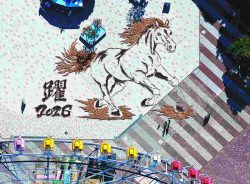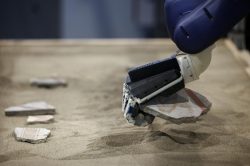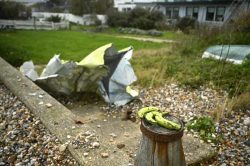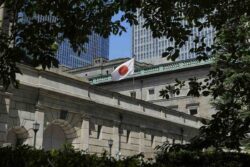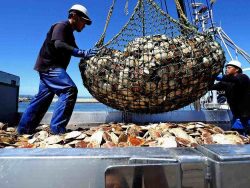Japan’s Drill-like Marching of Prisoners to Be Stopped, as Focus Shifts to Rehabilitation

Inmates walk inside Fuchu Prison in Fuchu, Tokyo, without receiving marching orders on Sept. 2.
12:35 JST, September 29, 2024
Prisons across the nation are reexamining how they treat inmates and rules for their daily conduct.
Some prisons, for example, have stopped making inmates march to drill-like commands, and some detention officers have started adding the honorific “san” after inmates’ surnames.
The changes have been made in response to legal changes — a new category of imprisonment called “kokinkei” will be introduced next year — and incidents of violence against inmates. However, there are still challenges at hand, such as how to maintain discipline inside prisons.
Under kokinkei imprisonment, inmates will work to rehabilitate themselves and receive the guidance they need toward this end. The emphasis will be on being reforming inmates instead of punishing them.
Kokinkei will replace the current categories of choekikei (imprisonment with labor) and kinkokei (imprisonment without labor).
Broader perspective
On Sept. 2, a detention officer ordered inmates to march at Fuchu Prison in Fuchu, Tokyo, where about 1,700 inmates are housed. “Forward,” commanded the officer, and about 40 inmates formed two lines and began their march.
The inmates walked at widely varying paces, and the movements of their arms and legs were not coordinated. They went from a factory space where they had been working to a bathroom tens of meters away. “Halt,” said the officer when they had reached the bathroom entrance.
Until recently at Fuchu Prison, there was a rule that inmates marching in a group had to bring their arms to a 60-degree angle in front of them and a 30-degree angle behind them. Detention officers would shout marching orders such as “Left, left, left, right,” and inmates had to match each other’s steps as they moved around the prison. These practices were changed in March.
“Before I was like a robot,” said a 51-year-old male inmate serving time for violating the Stimulants Control Law. “Now, I sometimes think I need to shorten my stride for those who have bad legs.”
“It’s more difficult for us to notice now when an inmate moves differently from the others,” said Toshiyuki Suzuki, a 45-year-old senior detention officer at the prison.
But he added, “Before, we only paid attention to whether their steps were coordinated. But now some detention officers say they can observe inmates from a broader perspective.”
Consideration for human rights
The practice of inmates marching in groups to commands is believed to have been modeled after military marches in the West and introduced in the Meiji era (1868-1912).
The practice is in part aimed at preventing inmates from escaping by making large numbers of inmates move in groups.
However, a growing emphasis on human rights led to a change in the law. In 2006, a prison law giving more consideration to inmates’ human rights took effect, and it was revised and broadened in 2007.
In 2022, a revision to the Penal Code, which laid out the creation of the new kokinkei category, was passed. The revision was aimed to placing more emphasis on rehabilitating inmates and keeping them from committing crimes again after their release from prison.
Also in 2022, it came to light that detention officers at Nagoya Prison had acted violently against inmates there.
After a third-party committee for the Justice Ministry suggested a change to the organizational culture among prison officers, the ministry decided to reexamine how inmates were treated in prison.
In March, the ministry abolished the practice of marching inmates with drill-like commands in 16 prisons including Fuchu Prison on a trial basis. As there have been no serious problems due to the change, the ministry decided to abolish the practice in all 174 detention facilities by the end of this fiscal year.
In February, detention officers also stopped using such slang as gari, meaning “a haircut.” From April, prison officers will add “san” to the end of all inmates’ names when speaking to them.
Going forward, the ministry will continue to reexamine inmate treatment, including the rule that inmates cannot lean against walls during their leisure time.
“We will keep a minimum level of rules to manage groups of inmates,” a ministry official said. “But due to the emphasis on rehabilitating them, we will review practices that are not seen in the real world.”
Balancing change, order
In reviewing how inmates are treated, the challenge will be to balance change and order.
As of the end of 2022, about 40,000 inmates were housed in prisons or other detention facilities.
Since inmates have to be managed in groups, excessively relaxing disciplinary rules could result in fights among inmates or attempts to escape from prison.
“To prevent released inmates from committing crimes again and to encourage them to rehabilitate themselves under kokinkei imprisonment, there needs to be a focus on how they can be self-reliant after returning to society,” said Prof. Manabu Nakajima of Fukuyama University, an expert on penal policy. “That means it’s important to handle them in an environment as similar to the real world as possible.”
“It is extremely important to maintain order, so there’s a need to try to adjust how much rules are relaxed depending on factors such as the inmate’s personality and age,” he added.
"Society" POPULAR ARTICLE
-

M4.9 Earthquake Hits Tokyo, Neighboring Prefectures
-

M7.5 Earthquake Hits Northern Japan; Tsunami Waves Observed in Hokkaido, Aomori and Iwate Prefectures
-

Tsukiji Market Urges Tourists to Avoid Visiting in Year-End
-

Israeli Tourists Refused Accommodation at Hotel in Japan’s Nagano Pref., Prompting Protest by Israeli Embassy and Probe by Prefecture
-
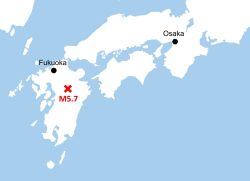
M5.7 Earthquake Hits Japan’s Kumamoto Pref., Measuring Upper 5 Intensity, No Tsunami Expected
JN ACCESS RANKING
-

Keidanren Chairman Yoshinobu Tsutsui Visits Kashiwazaki-Kariwa Nuclear Power Plant; Inspects New Emergency Safety System
-

Imports of Rare Earths from China Facing Delays, May Be Caused by Deterioration of Japan-China Relations
-

University of Tokyo Professor Discusses Japanese Economic Security in Interview Ahead of Forum
-

Japan Pulls out of Vietnam Nuclear Project, Complicating Hanoi’s Power Plans
-

Govt Aims to Expand NISA Program Lineup, Abolish Age Restriction




